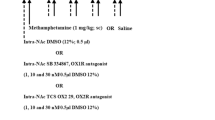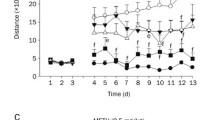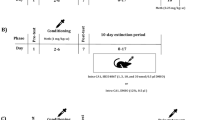Abstract
Cannabidiol (CBD) is a non-psychotomimetic compound with strong potential to decrease the psychostimulant’s rewarding effect with unclear receptors. Furthermore, as a part of the reward circuit, the hippocampus plays a crucial role in regulating the reward properties of drugs as determined by conditioned place preference (CPP). In the current research, CPP was used to evaluate the role of intra-CA1 microinjection of D1-like dopamine receptor antagonists in CBD's inhibitory effect on the acquisition and expression phases of methamphetamine (METH). Animals were treated by METH (1 mg/kg; sc) in a five-day schedule to induce CPP. To find out the impact of D1-like dopamine receptor antagonist, SCH23390, in the CA1 on the inhibitory influence of CBD on the acquisition of METH, the rats received intra-CA1 administration of SCH23390 (0.25, 1, and 4 µg/0.5 µl) following ICV treatment of CBD (10 µg/5 µl) over conditioning phase of METH. Furthermore, animals were given SCH23390 in the CA1 ensuing ICV microinjection of CBD (50 µg/5 µl) in the expression phase of METH to rule out the influence of SCH23390 on the suppressive effect of CBD on the expression of METH CPP. Intra-CA1 microinjection of SCH23390 abolished CBD's suppressive impact on both METH-induced CPP phases without any side effect on the locomotion. The current research disclosed that CBD inhibited the rewarding characteristic of METH via D1-like dopamine receptors in the CA1 region of the hippocampus.





Similar content being viewed by others
References
Krasnova IN, Cadet JL (2009) Methamphetamine toxicity and messengers of death. Brain Res Rev 60:379–407
Volkow ND, Morales M (2015) The brain on drugs: from reward to addiction. Cell 162:712–725
Cooper S, Robison AJ, Mazei-Robison MS (2017) Reward circuitry in addiction. Neurotherapeutics 14:687–697
Childs E, de Wit H (2009) Amphetamine-induced place preference in humans. Biol Psychiatry 65:900–904
Hyman SE, Malenka RC, Nestler EJ (2006) Neural mechanisms of addiction: the role of reward-related learning and memory. Annu Rev Neurosci 29:565–598
Alizamini MM, Kavianpour M, Karimi-Haghighi S, Fatahi Z, Haghparast A (2018) Intra-hippocampal administration of orexin receptor antagonists dose-dependently attenuates reinstatement of morphine seeking behavior in extinguished rats. Peptides 110:40–46
Assar N, Mahmoudi D, Farhoudian A, Farhadi MH, Fatahi Z, Haghparast A (2016) D1- and D2-like dopamine receptors in the CA1 region of the hippocampus are involved in the acquisition and reinstatement of morphine-induced conditioned place preference. Behav Brain Res 312:394–404
Riahi E, Khodagholi F, Haghparast A (2013) Role of dorsal hippocampal orexin-1 receptors in associating morphine reward with contextual stimuli. Behav Pharmacol 24:237–248
Grilli M, Nisoli E, Memo M, Missale C, Spano PF (1988) Pharmacological characterization of D1 and D2 dopamine receptors in rat limbocortical areas. II. Dorsal hippocampus. Neurosci Lett 87:253–258
Dubovyk V, Manahan-Vaughan D (2018) Less means more: the magnitude of synaptic plasticity along the hippocampal dorso-ventral axis is inversely related to the expression levels of plasticity-related neurotransmitter receptors. Hippocampus 28:136–150
Haghparast A, Esmaeili MH, Taslimi Z, Kermani M, Yazdi-Ravandi S, Alizadeh AM (2013) Intrahippocampal administration of D2 but not D1 dopamine receptor antagonist suppresses the expression of conditioned place preference induced by morphine in the ventral tegmental area. Neurosci Lett 541:138–143
Kramar CP, Barbano MF, Medina JH (2014) Dopamine D1/D5 receptors in the dorsal hippocampus are required for the acquisition and expression of a single trial cocaine-associated memory. Neurobiol Learn Mem 116:172–180
Karimi-Haghighi S, Dargahi L, Haghparast A (2020) Cannabidiol modulates the expression of neuroinflammatory factors in stress- and drug-induced reinstatement of methamphetamine in extinguished rats. Addict Biol 25:e12740
Karimi-Haghighi S, Haghparast A (2018) Cannabidiol inhibits priming-induced reinstatement of methamphetamine in REM sleep deprived rats. Prog Neuropsychopharmacol Biol Psychiatry 82:307–313
Razavi Y, Shabani R, Mehdizadeh M, Haghparast A (2020) Neuroprotective effect of chronic administration of cannabidiol during the abstinence period on methamphetamine-induced impairment of recognition memory in the rats. Behav Pharmacol 31:385–396
De Carvalho CR, Takahashi RN (2017) Cannabidiol disrupts the reconsolidation of contextual drug-associated memories in Wistar rats. Addict Biol 22:742–751
Northcutt AL, Hutchinson MR, Wang X, Baratta MV, Hiranita T, Cochran TA, Pomrenze MB, Galer EL, Kopajtic TA, Li CM, Amat J, Larson G, Cooper DC, Huang Y, O’Neill CE, Yin H, Zahniser NR, Katz JL, Rice KC, Maier SF, Bachtell RK, Watkins LR (2015) DAT isn’t all that: cocaine reward and reinforcement require Toll-like receptor 4 signaling. Mol Psychiatry 20:1525–1537
Katsidoni V, Anagnostou I, Panagis G (2013) Cannabidiol inhibits the reward-facilitating effect of morphine: involvement of 5-HT1A receptors in the dorsal raphe nucleus. Addict Biol 18:286–296
Yang G, Liu L, Zhang R, Li J, Leung CK, Huang J, Li Y, Shen B, Zeng X, Zhang D (2020) Cannabidiol attenuates methamphetamine-induced conditioned place preference via the Sigma1R/AKT/GSK-3β/CREB signaling pathway in rats. Toxicol Res (Camb) 9:202–211
Pertwee RG (2008) The diverse CB1 and CB2 receptor pharmacology of three plant cannabinoids: delta9-tetrahydrocannabinol, cannabidiol and delta9-tetrahydrocannabivarin. Br J Pharmacol 153:199–215
Mecha M, Feliú A, Iñigo PM, Mestre L, Carrillo-Salinas FJ, Guaza C (2013) Cannabidiol provides long-lasting protection against the deleterious effects of inflammation in a viral model of multiple sclerosis: a role for A2A receptors. Neurobiol Dis 59:141–150
Ward SJ, McAllister SD, Kawamura R, Murase R, Neelakantan H, Walker EA (2014) Cannabidiol inhibits paclitaxel-induced neuropathic pain through 5-HT(1A) receptors without diminishing nervous system function or chemotherapy efficacy. Br J Pharmacol 171:636–645
Hassan S, Eldeeb K, Millns PJ, Bennett AJ, Alexander SP, Kendall DA (2014) Cannabidiol enhances microglial phagocytosis via transient receptor potential (TRP) channel activation. Br J Pharmacol 171:2426–2439
Mahgoub M, Keun-Hang SY, Sydorenko V, Ashoor A, Kabbani N, Al Kury L, Sadek B, Howarth CF, Isaev D, Galadari S, Oz M (2013) Effects of cannabidiol on the function of α7-nicotinic acetylcholine receptors. Eur J Pharmacol 720:310–319
Attarzadeh-Yazdi G, Arezoomandan R, Haghparast A (2014) Minocycline, an antibiotic with inhibitory effect on microglial activation, attenuates the maintenance and reinstatement of methamphetamine-seeking behavior in rat. Prog Neuropsychopharmacol Biol Psychiatry 53:142–148
Anooshe M, Nouri K, Karimi-Haghighi S, Mousavi Z, Haghparast A (2021) Cannabidiol efficiently suppressed the acquisition and expression of methamphetamine-induced conditioned place preference in the rat. Behav Brain Res 404:113158
Khanegheini A, Khani M, Zarrabian S, Yousefzadeh-Chabok S, Taleghani BK, Haghparast A (2021) Cannabidiol enhanced the development of sensitization to the expression of methamphetamine-induced conditioned place preference in male rats. J Psychiatr Res 137:260–265
Zakeri M, Soltanizadeh S, Karimi-Haghighi S, Haghparast A (2020) Modulatory role of hippocampal dopamine receptors in antinociceptive responses induced by chemical stimulation of the lateral hypothalamus in an animal model of persistent inflammatory pain. Brain Res Bull 162:253–260
Paxinos G, Watson C (2007) The rat brain in stereotaxic coordinates, 6th edn. Elsevier, San Diego
Farzinpour Z, Taslimi Z, Azizbeigi R, Karimi-Haghighi S, Haghparast A (2019) Involvement of orexinergic receptors in the nucleus accumbens, in the effect of forced swim stress on the reinstatement of morphine seeking behaviors. Behav Brain Res 356:279–287
Khosrowabadi E, Karimi-Haghighi S, Jamali S, Haghparast A (2020) Differential roles of intra-accumbal orexin receptors in acquisition and expression of methamphetamine-induced conditioned place preference in the rats. Neurochem Res 45:2230–2241
Groman SM, Rich KM, Smith NJ, Lee D, Taylor JR (2018) Chronic exposure to methamphetamine disrupts reinforcement-based decision making in rats. Neuropsychopharmacology 43:770–780
Blanco-Gandía MC, Aguilar MA, Miñarro J, Rodríguez-Arias M (2018) Reinstatement of drug-seeking in mice using the conditioned place preference paradigm. J Vis Exp 136:e56983
Goodman J, Packard MG (2016) Memory systems and the addicted brain. Front Psychiatry 7:24
Smith DM, Mizumori SJ (2006) Learning-related development of context-specific neuronal responses to places and events: the hippocampal role in context processing. J Neurosci 26:3154–3163
Meyers RA, Zavala AR, Speer CM, Neisewander JL (2006) Dorsal hippocampus inhibition disrupts acquisition and expression, but not consolidation, of cocaine conditioned place preference. Behav Neurosci 120:401–412
Zhou Y, Zhu H, Liu Z, Chen X, Su X, Ma C, Tian Z, Huang B, Yan E, Liu X, Ma L (2019) A ventral CA1 to nucleus accumbens core engram circuit mediates conditioned place preference for cocaine. Nat Neurosci 22:1986–1999
Han WY, Du P, Fu SY, Wang F, Song M, Wu CF, Yang JY (2014) Oxytocin via its receptor affects restraint stress-induced methamphetamine CPP reinstatement in mice: Involvement of the medial prefrontal cortex and dorsal hippocampus glutamatergic system. Pharmacol Biochem Behav 119:80–87
Liu W, Peng QX, Lin XL, Luo CH, Jiang MJ, Mo ZX, Yung KK (2014) Effect of rhynchophylline on the expression of p-CREB and sc-Fos in triatum and hippocampal CA1 area of methamphetamine-induced conditioned place preference rats. Fitoterapia 92:16–22
Tan SE (2008) Roles of hippocampal NMDA receptors and nucleus accumbens D1 receptors in the amphetamine-produced conditioned place preference in rats. Brain Res Bull 77:412–419
Cortés R, Gueye B, Pazos A, Probst A, Palacios JM (1989) Dopamine receptors in human brain: autoradiographic distribution of D1 sites. Neuroscience 28:263–273
Savasta M, Dubois A, Scatton B (1986) Autoradiographic localization of D1 dopamine receptors in the rat brain with [3H]SCH 23390. Brain Res 375:291–301
Broussard JI, Yang K, Levine AT, Tsetsenis T, Jenson D, Cao F, Garcia I, Arenkiel BR, Zhou FM, De Biasi M, Dani JA (2016) Dopamine regulates aversive contextual learning and associated in vivo synaptic plasticity in the hippocampus. Cell Rep 14:1930–1939
McNamara CG, Tejero-Cantero Á, Trouche S, Campo-Urriza N, Dupret D (2014) Dopaminergic neurons promote hippocampal reactivation and spatial memory persistence. Nat Neurosci 17:1658–1660
Smith CC, Greene RW (2012) CNS dopamine transmission mediated by noradrenergic innervation. J Neurosci 32:6072–6080
Kramar CP, Chefer VI, Wise RA, Medina JH, Barbano MF (2014) Dopamine in the dorsal hippocampus impairs the late consolidation of cocaine-associated memory. Neuropsychopharmacology 39:1645–1653
Saika F, Kiguchi N, Wakida N, Kobayashi D, Fukazawa Y, Matsuzaki S, Kishioka S (2018) Upregulation of CCL7 and CCL2 in reward system mediated through dopamine D1 receptor signaling underlies methamphetamine-induced place preference in mice. Neurosci Lett 665:33–37
Campos AC, Fogaça MV, Sonego AB, Guimarães FS (2016) Cannabidiol, neuroprotection and neuropsychiatric disorders. Pharmacol Res 112:119–127
Tham M, Yilmaz O, Alaverdashvili M, Kelly MEM, Denovan-Wright EM, Laprairie RB (2019) Allosteric and orthosteric pharmacology of cannabidiol and cannabidiol-dimethylheptyl at the type 1 and type 2 cannabinoid receptors. Br J Pharmacol 176:1455–1469
Seeman P (2016) Cannabidiol is a partial agonist at dopamine D2High receptors, predicting its antipsychotic clinical dose. Transl Psychiatry 6:e920
Kathmann M, Flau K, Redmer A, Tränkle C, Schlicker E (2006) Cannabidiol is an allosteric modulator at mu- and delta-opioid receptors. Naunyn Schmiedebergs Arch Pharmacol 372:354–361
Hartmann A, Lisboa SF, Sonego AB, Coutinho D, Gomes FV, Guimarães FS (2019) Cannabidiol attenuates aggressive behavior induced by social isolation in mice: involvement of 5-HT1A and CB1 receptors. Prog Neuropsychopharmacol Biol Psychiatry 94:109637
Jesus CHA, Redivo DDB, Gasparin AT, Sotomaior BB, de Carvalho MC, Genaro K, Zuardi AW, Hallak JEC, Crippa JA, Zanoveli JM, da Cunha JM (2019) Cannabidiol attenuates mechanical allodynia in streptozotocin-induced diabetic rats via serotonergic system activation through 5-HT1A receptors. Brain Res 1715:156–164
Hind WH, England TJ, O’Sullivan SE (2016) Cannabidiol protects an in vitro model of the blood-brain barrier from oxygen-glucose deprivation via PPARγ and 5-HT1A receptors. Br J Pharmacol 173:815–825
Ren Y, Whittard J, Higuera-Matas A, Morris CV, Hurd YL (2009) Cannabidiol, a nonpsychotropic component of cannabis, inhibits cue-induced heroin seeking and normalizes discrete mesolimbic neuronal disturbances. J Neurosci 29:14764–14769
Galaj E, Bi GH, Yang HJ, Xi ZX (2020) Cannabidiol attenuates the rewarding effects of cocaine in rats by CB2, 5-HT(1A) and TRPV1 receptor mechanisms. Neuropharmacology 167:107740
Acknowledgements
This project was supported by the Vice-Chancellor for Research & Technology of Shahid Beheshti University of Medical Sciences (Grant No. 00-26809-1400-01-25). Also the authors would like to thank the Neuroscience Research Center, Shahid Beheshti University of Medical Sciences, Tehran, Iran for conducting this study.
Author information
Authors and Affiliations
Contributions
AH was responsible for the study concept and design. KN and MA contributed to the acquisition of behavioral data. AH, SK-H and ZM assisted with data analysis and interpretation of findings. KN and SK-H drafted the manuscript. AH provided critical revision of the manuscript for important intellectual content. All authors critically reviewed content and approved the final version for publication.
Corresponding author
Ethics declarations
Conflict of interest
The authors declare that there were no conflicts of interest.
Additional information
Publisher's Note
Springer Nature remains neutral with regard to jurisdictional claims in published maps and institutional affiliations.
Rights and permissions
About this article
Cite this article
Nouri, K., Anooshe, M., Karimi-Haghighi, S. et al. Involvement of Hippocampal D1-Like Dopamine Receptors in the Inhibitory Effect of Cannabidiol on Acquisition and Expression of Methamphetamine-Induced Conditioned Place Preference. Neurochem Res 46, 2008–2018 (2021). https://doi.org/10.1007/s11064-021-03350-w
Received:
Revised:
Accepted:
Published:
Issue Date:
DOI: https://doi.org/10.1007/s11064-021-03350-w




